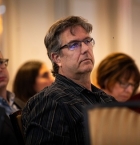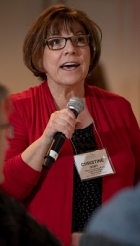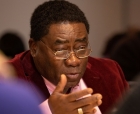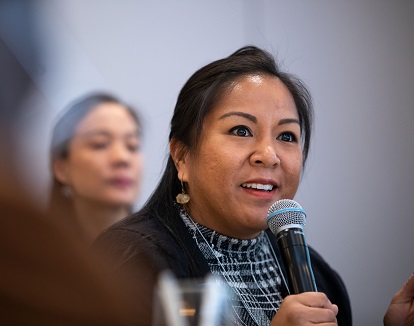What more – or different – actions can funders and a funder group take to build multiracial majorities strong enough to protect environmental health and justice? HEFN dove into this question through both learning and culture change at its 2018 annual meeting on “The Environmental Health and Justice Majority: Raising Voices, Building Power.”

“Philanthropy can’t accomplish this on its own, and, in fact the process begins with a recognition that most of the heavy lifting — the organizing, the movement-building, the grassroots campaigning, the local leadership development, the civic engagement and the policy wins needed to deliver real impact — will be done by our grantees and others,” said Jonathan Scott (pictured, left), Singing Field Foundation.
That spirit motivated HEFN to pilot a Field Partner program, inviting members to bring one grantee-partner to this year’s annual meeting, traditionally a funder-only event. This change was inspired by a great model developed by the Sustainable Agriculture & Food Systems Funders for their annual Forum. It also reflected HEFN’s strategic priorities including ensuring those impacted have a meaningful voice in decision making.
The pilot was enthusiastically embraced by the 50+ funders and eleven Field Partners participating in the HEFN meeting in Pittsburgh last month. Benefits included building relationships, richer conversations about problems, and joint strategizing about potential solutions.

“HEFN members tend to be focused on community impact and with that discipline already motivating so many of our members, the presence of field partners who were willing to share their knowledge and experience as well as challenge funders was a fruitful addition to what is always one of the best annual conferences,” said Cris Doby (pictured, left), Fred A. and Barbara M. Erb Foundation.
“Being present for the sessions helped me understand the multitude of issues and demands that funders are juggling,” said Karen Wang of the Collaborative for Health and the Environment, and field partner of the Jenifer Altman Foundation. “These insights will definitely help inform our funder relationships going forward.”
“The silos and power relationships of conventional philanthropy, grantmaker networks and convenings stand as major barriers to making progress on the issues which are core to our environmental and social change missions,” added Jonathan, whose field partner guest was Myron Arnowitt from Clean Water Action.
This year’s meeting also expanded time spent in visits to local communities and shifted a common focus from learning tours into shared brainstorming and strategy discussions. One of two site visits focused on “Disrupting Pollution: Technology-Boosted Community Action on Air and Water Quality.” Participants met with community members from Clairton and Homewood, talking about ways of protecting health from multiple pressures including heavy industrial pollution, aging housing stock, low income and employment opportunity, and gentrification.
In planning this site visit, we had asked community leaders what they most hoped to gain from the conversation (as well as what we could learn from them). Guided by that, HEFN invited Field Partners with relevant experiences to actively participate in the Pittsburgh community conversations.


“When having open discussions about culturally sensitive issues like environmental justice, it is important to make sure the voices of persons who live and work in these communities are heard,” said Harold Rickenbacker (pictured, far left) with the Cancer Free Economy Network, and field partner of the Garfield Foundation. “This is often a large part of the healing process for communities, but also a pivotal point where emotions may shift from those affected to those who systemically have the power to implement change.”
That point was illustrated during our visit to the Community Economic Development Center of Clairton. After community members shared “legacy of loss” experiences of multiple family deaths related to unhealthy environments, several veteran environmental justice leaders present as Field Partners shared inspiring stories of successes. Responsive words from Rev. Leo Woodberry (pictured, left), New Alpha Community Development Corporation and Ceres Trust’s field partner, opened a space of comfort and courage.
Thank you to everyone who attended our 2018 Annual Meeting, and special thanks to our HEFN member funder hosts and Field Partner guests for being part of what we hope is a new component to future events. Look for more highlights and photos from the event in the upcoming blog, 2018 HEFN Year in Review, to be posted in January.
(Photo at the top left of blog posting: Darryl Molina Sarmiento of Communities for a Better Environment, guest field partner of the Marisla Foundation. Annie O’Sullivan Photography)

